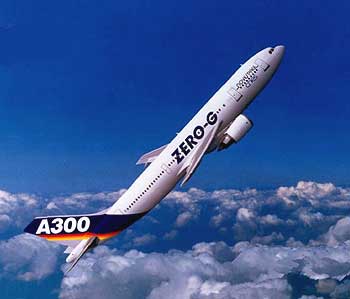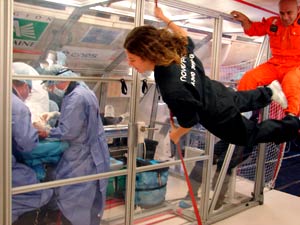| SPACE MEDICINE
Surgery in Space |
|
|
.
Wednesday, September 27, 2006 French surgeons operate under zero gravity French physicians have announced that they plan to conduct an experiment to perfect surgical techniques in zero-gravity; however, neither patient or physician will have to risk the trip into orbit. Rather, they will simply have to stomach 20-30 gut wrenching, over the top roller coaster maneuvers strapped to the inside of a giant A300 Airbus dubbed “Zero-G”, which is owned and operated by the European Space Agency. French surgeon Dominique Martin plans to remove surgically a cyst from the arm of patient Phillipe Sanchot during a three-hour operation. The routine operation will involve short periods of weightlessness as the Airbus arcs over the peak of a steep climb and free falls simulating a few moments of weightlessness. The sensation is what we feel when an automobile suddenly seems to leave the ground as it clears a small rise in the road. For year’s NASA has used such a flight technique to condition its astronauts for functioning in zero gravity conditions prior to sending them into orbit. During these flight training sessions, astronauts typically float freely about the inside of the padded fuselage, learning to twist and turn their bodies under conditions approximating weightlessness. For the surgeon and patient such free floating acrobatics will not work however. Strapped to the inside of the plane’s wall Dr. Martin will have to control his surgical tools and work to steady one instrument after another as the surgery progresses through a series of stops and starts. Sanchot, an extreme sports enthusiast was chosen for the experiment because he is an avid bungee jumper and is use to the sensation of freefall. The team of surgeons will also learn how to control stray bits of material such as blood, serum or tissue typically released during surgery. Under normal circumstances, this loose material would be held by gravity inside the area of the surgical site until removed by a physician or physician’s attendant. Space physicians and scientists hope that by conducting such experiments in zero-gravity surgery, they can to add to their body of knowledge regarding future possible surgery preformed by astronauts and or surgical robots during missions to the International Space Station. For further reading on experiments with remote surgical techniques, called tele-surgery read our interview with NASA astronauts aboard the underwater sea lab NEEMO earlier this year. Harlan Weikle
|
|
|
.
by Elizabeth Raymer If scientists can put a man on the moon, or send him
into space for a few years at time, can they enable astronauts to perform
complex surgical procedures there, too?
Professor Adam Dubrowksi of surgery doesn’t see why not, and he’s making space surgery a focus of his research. There’ll be a need for it once astronauts in the International Space Station begin to stay on board for extended periods, says Dubrowski, who is also a kinesiologist in the Surgical Skills Centre at Mount Sinai Hospital. The U.S. National Aeronautics and Space Administration (NASA) and the Canadian Space Agency (CSA) are also looking towards a mission to Mars, a journey that will take three to four years each way. “The longer you stay, the more potential there is for things to happen,” Dubrowski points out, noting that lacerations and trauma injuries are certainly possible. Currently, astronauts get a few hours of medical training on the ground, which is insufficient for treating more serious injuries, he says. Although typically a medical doctor is on board the space station, “everybody has to know a bit of everything.” On longer missions, he anticipates having a physician and a highly skilled medical assistant who are both trained in surgery, while the rest of the crew will be trained in the basics. Currently, emergencies are dealt with on board the space station and surgery can be performed using a remote-controlled robot. But as spaceships get further away from Earth, robotic surgery is no longer possible because the signals take longer to reach the mission, Dubrowski explains. And “no one understands what happens when you’re in zero gravity” and need to suture or staple a wounded person. So Dubrowski, his wife, Waterloo kinesiology professor Heather Carnahan, and Dr. Gary Gray, a Canadian Space Agency consultant from Defence Research and Development Canada, hope to explore these questions with CSA funding. The three have already conducted zero-gravity research into basic motor skills such as touching one’s nose or tying one’s shoes. A weightless environment affects a person’s hand-eye co-ordination, aim and ability to apply a certain amount of force when undertaking tasks, he says. Dubrowski’s interest in space research began after he received his PhD in kinesiology in 2001 from the University of Waterloo. A native of Poland who immigrated to the Toronto area, Dubrowski was influenced by a visit to Dr. Otmar Bock, a leading German researcher in zero-gravity, following completion of his doctoral studies. The two maintained a collaboration, which helped Dubrowski get funding from the European Space Agency and the German Space Agency. Now, the Canadian Space Agency plans to develop a surgery training protocol for astronauts and Dubrowski, Carnahan and Gray — with the support of the experts from the Surgical Skills Centre and the Wilson Centre — plan to bid for the contract. At the same time, they will be applying for smaller funds for parabolic flight research. Space-surgery training will be three-pronged, Dubrowski explains. The first step is adaptation to zero gravity using an inverted paradigm in which experimental participants are placed upside down on something similar to a bed to “get more of an idea of weightlessness.” The second step will be simulating zero gravity in a swimming pool; Dubrowski and Surgical Skills Centre manager Lisa Satterthwaite are working on procuring something similar to the huge swimming pool with the replica of the space station used in the NASA centre in Houston. “You can adjust the buoyancy of the person so they’re suspended in water,” Dubrowski says. “That’s another way of simulating zero gravity.” Third, trainees will take their basic surgery skills on parabolic flights in which an airplane ascends and descends roughly 40 times, creating a transient zero-gravity environment on the descents. Dubrowski uses a variety of simple and complex simulators to allow students at the Surgical Skills Centre to practise skills such as stitching with skin patches. Surgery in space isn’t that far away, Dubrowksi predicts; there are plans to put a manned lunar base on the moon in the next five to 10 years, which will necessitate better surgical skills for the longer missions. And the sooner the better, he says. |
|
|
Scientists Find Evidence of Ancient Microbial Life on Mars Moffett Field - Feb. 26, 2001 An international team of researchers has discovered compelling evidence that the magnetite crystals in the martian meteorite ALH84001 are of biological origin. The researchers found that the magnetite crystals embedded in the meteorite are arranged in long chains, which they say could have been formed only by once-living organisms. Their results are reported in the Feb. 27 Proceedings of the National Academy of Sciences. "The chains we discovered are of biological origin," said Dr. Imre Friedmann, an NRC senior research fellow at NASA's Ames Research Center in California's Silicon Valley and leader of the research team. "Such a chain of magnets outside an organism would immediately collapse into a clump due to magnetic forces," he said. The chains were formed inside organic material whose structure held the crystals together. "The end result looks somewhat like a string of pearls," Friedmann noted. Each magnetite crystal in the chain is a tiny magnet, approximately one-millionth of an inch in diameter. Magnetite is an iron oxide, similar to iron rust. The chains may have served as 'compasses' for the host magnetotactic bacteria, so named because they navigate with the help of the magnetic crystal chains inside their bodies. The chains were preserved in the meteorite long after the bacteria themselves decayed. The researchers say the magnetite chains probably were flushed into microscopic cracks inside the martian rock after it was shattered by an asteroid impact approximately 3.9 billion years ago. This cataclysmic event on Mars' surface also may have killed the bacteria. The same, or a later, asteroid impact ejected the rock, now a meteorite, into space. Another NASA research group, led by Kathie Thomas-Keprta of NASA's Johnson Space Center, report in the same issue of PNAS that the magnetite crystals inside the meteorite are similar to those formed by 'modern' magnetotactic bacteria now living on Earth. The team studied only single crystals, however, not the elusive chain-like structures. Friedmann's team discovered the crystal chains using a technique that enabled them to 'see' the tiny chains inside the meteorite without destroying them. Besides the chain-like formation, the team discovered that individual crystals are of similar size and shape, do not touch each other and that the chains themselves are flexible, further evidence of biological origin. "Until now, studying life has been like trying to draw a curve using only one data point -- life on Earth," said Friedmann. "Now we have two data points to draw life's curve." The next step is to find the remains of the bacteria themselves, he said. The fact that a small (about 4-pound) meteorite from a planet contains large numbers of bacteria suggests that such bacteria were widespread on the surface of Mars, the researchers say. A stone of similar size from Earth would contain many bacteria. In addition, since magnetotactic bacteria require low levels of oxygen, this finding indicates that photosynthetic organisms, the source of oxygen in the atmosphere, must have been present and active on Mars 3.9 billion years ago. "Finding evidence of life on Mars is one of the central problems in astrobiology research today," said Dr. Michael Meyer, head of NASA's astrobiology program, which funded the research. In addition to his fellowship at NASA Ames, Friedmann, who is best known for discovering microorganisms living inside desert rocks, is professor emeritus of biological science at Florida State University. Members of the research team include Dr. Jacek Wierzchos (University of Lleida, Spain), Dr. Carmen Ascaso (CSIC, Madrid, Spain), and Dr. Michael Winkelhofer (University of Munich, Germany). The meteorite ALH84001 was found in the Allen Hills region of Antarctica in 1984 by researchers supported by the National Science Foundation's Antarctic Search for Meteorites Program, a joint effort by the NSF, the Smithsonian Institution and NASA. Case Western Reserve University in Cleveland manages the program. |
|
| FAIR USE NOTICE: This page contains copyrighted material the use of which has not been specifically authorized by the copyright owner. Pegasus Research Consortium distributes this material without profit to those who have expressed a prior interest in receiving the included information for research and educational purposes. We believe this constitutes a fair use of any such copyrighted material as provided for in 17 U.S.C § 107. If you wish to use copyrighted material from this site for purposes of your own that go beyond fair use, you must obtain permission from the copyright owner. | |
|
|


